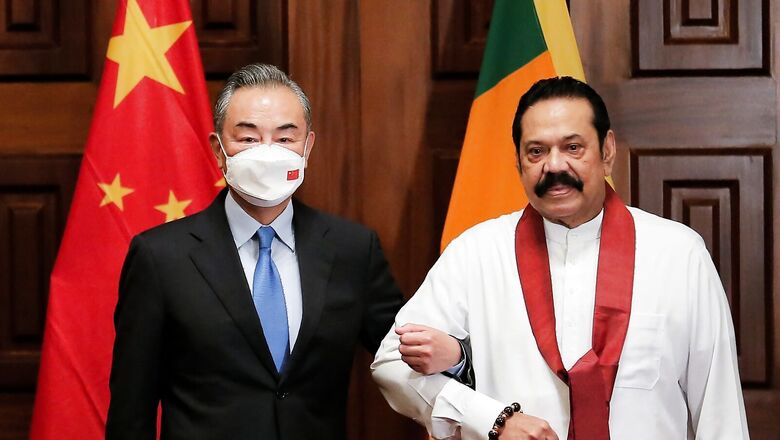
views
On January 9, Chinese Foreign Minister Wang Yi concluded his five-nation Indian Ocean trip with his departure from Sri Lanka. During a 24-hour visit to Colombo, Wang launched the celebrations for the 65th anniversary of China-Sri Lanka relations by inaugurating the promenade of the Colombo Port City, a flagship Belt and Road project. Wang’s talks with the Sri Lankan leaders took place in the backdrop of possibly the worst foreign exchange crisis in the Island’s history. Thus, Foreign Minister G.L. Peiris commenced the talks by reminding the visitor that the proverb “a friend in need is a friend indeed, is the eternal theme of bilateral relations”. Similarly, Prime Minister Mahinda Rajapaksa thanked China for “always lending a helping hand” during Sri Lanka’s time of urgent need.
Similar hopes were gratuitously expressed by President Gotabaya Rajapaksa who asked the visitor “if attention could be paid on restructuring the debt repayments as a solution to the economic crisis”. He also requested China to provide a “concessional” trade-credit for its exports to Sri Lanka, which amounted to $3.5 billion in 2021.
Wang, however, remained non-committal on further relief. Having already bailed out the island nation with $1 billion in loan and $1.5 billion in a currency swap deal since March 2020, Wang avoided any promise of further help. Instead, he pushed for restarting the negotiations for a free trade agreement (FTA) to aid Sri Lanka’s economic recovery. Notably, Wang chose to focus on the 1952 Rubber-Rice Pact rather than the major event of his visit – the 65th anniversary of the diplomatic relationship between China and Sri Lanka.
The Rubber-Rice Pact was signed between the two countries in 1952 when the end of the Korean war boom had led to fall in rubber prices, one of the major export items for Sri Lanka. As the island nation faced a foreign exchange crisis, it became unable to secure cheap rice supply for its population. At the same time, China was struggling to secure rubber supply, following the May 1951 UN resolution, which had banned sale of rubber to China. The signing of the Rubber-Rice Pact ultimately paved the way for establishment of diplomatic relationship between the two countries in 1957. As Wang Yi put it, the Pact was signed on the “basis of equal negotiations,” which “broke the cold war isolation” of China and “created the spirit of independence, self-reliance, unity and mutual support” between the two countries.
Wang’s urge for “equal negotiations” with Sri Lanka is particularly interesting since the Chinese leaders have enjoyed a patron-client relationship with the ruling Rajapaksa regime for a long time. Yet, the Chinese call for reciprocity in its dealings with Sri Lankan leaders offers cues about the slide in Beijing’s fortunes in the island nation. Sri Lanka’s inability to deliver “rubber” as a swap for “rice” from China is becoming a major source of irritation. With major BRI projects – Hambantota Port and Colombo Port City Project – already completed, China is stuck in its relationship with Sri Lanka. While the demands of the Rajapaksa regime with preferential loans and bailouts continue, Colombo is hardly in any position to offer other grand projects to Beijing. This has become particularly true after the recent rise in anti-China sentiment in Sri Lanka.
After the controversial enactment of the Colombo Port City Economic Commission (CPCEC) Act in May 2021, China has become a primary target of the Sinhalese Buddhist nationalists in Sri Lanka. The suspicions of the Port City becoming a Chinese enclave in Sri Lanka outside the authority of Parliament led to an anti-CPCEC mobilisation by the Sri Lankan opposition, civil society and religious leaders. Since then, the Rajapaksa regime has struggled to advance the Chinese projects in Sri Lanka.
Thus, when in July 2021, a Chinese company tried to get the presidential secretary to intervene on its behalf, there was immediate pushback from the chairman of the CPCEC. Similarly, China’s success in forcing the Sri Lankan government to pay $6.7 million as compensation due to Colombo’s rejection of the import of contaminated fertiliser generated a backlash in Sri Lanka. Then, in November 2021, Sri Lanka cancelled a Chinese renewable energy project after India offered to provide a grant of $12 million to execute the project. This led to a statement by the Chinese embassy on Twitter calling out the security concerns of a “third party” behind the cancellation.
ALSO READ | As China Fishes in Lankan Waters, India Must Assess Cost and Benefit of Bailing out Neighbour
In this regard, Wang’s emphasis on “equal negotiations” was made simultaneously with an assertion that the China-Sri Lanka relationship “does not target any third party and should not be interfered with by any third party.” The mention of “third party”, a euphemism for India’s influence in Sri Lanka, comes after prolonged Indian efforts to counter the increasing Chinese influence in the region. Particularly, New Delhi’s success in persuading Colombo to cancel the Chinese renewable energy project, located about 50 kilometres from the Indian mainland, has been duly noted in Beijing.
Further, as the Chinese loans are drying up, India has stepped up to provide an economic package worth $2.4 billion in preferential loans and line of credit. Consequently, Sri Lanka has begun to re-emphasise the “India first” nature of its foreign policy and is looking to integrate its economy with India to take advantage of the Indian market. This is in marked contrast with the February 2021 statement by then Sri Lankan Foreign Minister when he had regarded China as Sri Lanka’s “closest friend” and a “growing force” for its “independent development”.
Therefore, Wang’s push for “equal negotiations” between the two countries was not only aimed at the Sri Lankan public opinion to counter the growing narrative of Chinese dominance on the Sri Lankan society. It is also Colombo’s balancing of Beijing with the support from New Delhi which has generated a Chinese demand on the ruling Rajapaksa regime to offer it the same opportunities as accorded to New Delhi.
However, the space for the Rajapaksa regime to deliver on the Chinese demands will continue to shrink due to opposition from its domestic allies – Sinhalese Buddhist nationalists. Thus, to act on its domestic compulsions, the government is likely to continue its rapprochement with India. Further, Sri Lanka’s growing desire to go to IMF to ameliorate its economic problem makes it likely that it will have to mute its opposition to the US Indo-Pacific strategy. This creates a tailormade case for Indo-US convergence in the Indo-Pacific to pull Sri Lanka out of China’s debt-trap.
Shrey Khanna is Research Analyst working on the Indo-Pacific Studies Programme at The Takshashila Institution. The views expressed in this article are those of the author and do not represent the stand of this publication.
Read all the Latest Opinions here



















Comments
0 comment